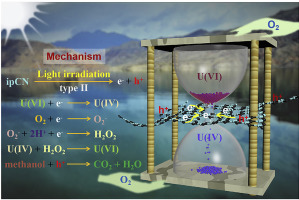Environmental Pollution ( IF 7.6 ) Pub Date : 2020-01-25 , DOI: 10.1016/j.envpol.2020.114070 Zhanggao Le 1 , Chuanbao Xiong 2 , Junyuan Gong 3 , Xi Wu 4 , Tao Pan 3 , Zhongsheng Chen 4 , Zongbo Xie 4

|
Photocatalysis is a promising method to eliminate hexavalent uranium (U(Ⅵ)) and recycle it from wastewater. However, most of researched photocatalysts are metal-contained, inactive in visible light, and inconvenient to recycle, which unfortunately impedes the further utilization of photocatalytic technology in U(Ⅵ) pollution treatment. Herein, g-C3N4 isotype heterojunction with interpenetrated tri-s-triazine structure (ipCN) was prepared by inserting urea into the interlayer of tri-s-triazine planes of thiourea-derived g-C3N4 and in-site thermal treating. The synthesized nanocomposites were used to convert soluble U(Ⅵ) ions into U(Ⅳ) sediment under visible light. Experimental and characterization results reveal that ipCN possess larger BET surface area, more negative-charged surface, higher U(Ⅵ) adsorption capability, and more efficient mass diffusion and charges transfer properties. With these excellent characteristics, nearly 98% U(Ⅵ) could be removed within 20 min over ipCN5:1 and 92% photoreduction efficiency could also be kept after 7 cycle uses, which were equal to or even superior than most reported metal-based photocatalysts. It is also proven that the configuration of U(Ⅵ) and photogenerated ·O2− play a significant role in the photocatalytic U(Ⅵ) reduction process, with (UO2)x(OH)y2x-y are more prone to be adsorbed and the photoinduced process of ·O2− will steal electrons from photocatalysts. Furthermore, with the self-generated ·O2− and H2O2, a green and facile regeneration process of photocatalysts was proposed This work provides a promising scheme to extract U(Ⅵ) from the perspectives of photocatalysts exploitation, photocatalytic reduction, and photocatalysts regeneration, which is meaningful for the sustainable U(Ⅵ) resource recovery and U(Ⅵ) pollution purification.
中文翻译:

自清洁同型g-C3N4异质结,可在可见光下有效地光催化还原六价铀。
光催化是一种有希望的方法,可消除六价铀(U(Ⅵ))并将其从废水中回收。然而,大多数研究的光催化剂是含金属的,在可见光下没有活性,并且不方便回收利用,这不幸地阻碍了光催化技术在U(Ⅵ)污染处理中的进一步利用。在此,通过将尿素插入硫脲衍生的gC 3 N 4的三-s-三嗪平面的夹层中,制备具有互穿的三-s-三嗪结构(ipCN)的gC 3 N 4异型异质结。和现场热处理。合成的纳米复合材料用于在可见光下将可溶性U(Ⅵ)离子转化为U(Ⅳ)沉积物。实验和表征结果表明,ipCN具有更大的BET表面积,更多的带负电荷的表面,更高的U(Ⅵ)吸附能力以及更有效的质量扩散和电荷转移特性。具有这些出色的特性,在20分钟内可以通过ipCN 5:1去除近98%的U(Ⅵ),并且在7次循环使用后还可以保持92%的光还原效率,这与大多数报道的金属基材料相同甚至更好。光催化剂。它也证明了U(Ⅵ)的配置和光生·O2 2 -发挥光催化U(Ⅵ)还原过程中显著作用,(UO2)X(OH)ý 2X-Y更容易被吸附和的光诱导过程·O2 2 -将从光催化剂盗取电子。此外,通过自生·O2 2 -和H 2 ö 2提出,绿色和容易再生的光催化剂的方法这项工作提供了一个有希望的方案,从光催化剂剥削,光催化还原的角度提取U(Ⅵ),和光催化剂的再生,对于可持续的U(Ⅵ)资源回收和U(Ⅵ)污染净化具有重要意义。











































 京公网安备 11010802027423号
京公网安备 11010802027423号